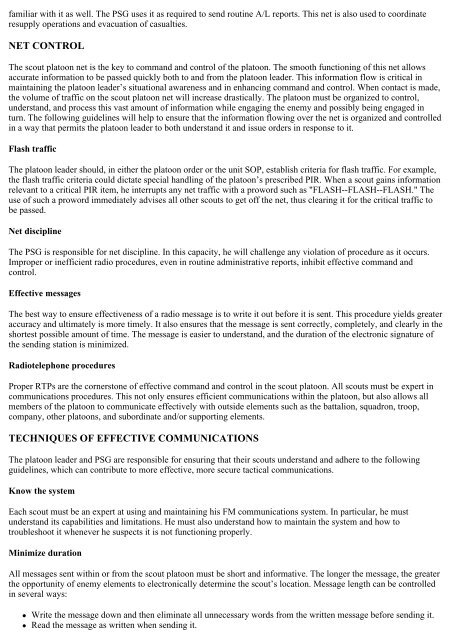FM 17-98 SCOUT PLATOON
FM 17-98 SCOUT PLATOON
FM 17-98 SCOUT PLATOON
You also want an ePaper? Increase the reach of your titles
YUMPU automatically turns print PDFs into web optimized ePapers that Google loves.
familiar with it as well. The PSG uses it as required to send routine A/L reports. This net is also used to coordinate<br />
resupply operations and evacuation of casualties.<br />
NET CONTROL<br />
The scout platoon net is the key to command and control of the platoon. The smooth functioning of this net allows<br />
accurate information to be passed quickly both to and from the platoon leader. This information flow is critical in<br />
maintaining the platoon leader’s situational awareness and in enhancing command and control. When contact is made,<br />
the volume of traffic on the scout platoon net will increase drastically. The platoon must be organized to control,<br />
understand, and process this vast amount of information while engaging the enemy and possibly being engaged in<br />
turn. The following guidelines will help to ensure that the information flowing over the net is organized and controlled<br />
in a way that permits the platoon leader to both understand it and issue orders in response to it.<br />
Flash traffic<br />
The platoon leader should, in either the platoon order or the unit SOP, establish criteria for flash traffic. For example,<br />
the flash traffic criteria could dictate special handling of the platoon’s prescribed PIR. When a scout gains information<br />
relevant to a critical PIR item, he interrupts any net traffic with a proword such as "FLASH--FLASH--FLASH." The<br />
use of such a proword immediately advises all other scouts to get off the net, thus clearing it for the critical traffic to<br />
be passed.<br />
Net discipline<br />
The PSG is responsible for net discipline. In this capacity, he will challenge any violation of procedure as it occurs.<br />
Improper or inefficient radio procedures, even in routine administrative reports, inhibit effective command and<br />
control.<br />
Effective messages<br />
The best way to ensure effectiveness of a radio message is to write it out before it is sent. This procedure yields greater<br />
accuracy and ultimately is more timely. It also ensures that the message is sent correctly, completely, and clearly in the<br />
shortest possible amount of time. The message is easier to understand, and the duration of the electronic signature of<br />
the sending station is minimized.<br />
Radiotelephone procedures<br />
Proper RTPs are the cornerstone of effective command and control in the scout platoon. All scouts must be expert in<br />
communications procedures. This not only ensures efficient communications within the platoon, but also allows all<br />
members of the platoon to communicate effectively with outside elements such as the battalion, squadron, troop,<br />
company, other platoons, and subordinate and/or supporting elements.<br />
TECHNIQUES OF EFFECTIVE COMMUNICATIONS<br />
The platoon leader and PSG are responsible for ensuring that their scouts understand and adhere to the following<br />
guidelines, which can contribute to more effective, more secure tactical communications.<br />
Know the system<br />
Each scout must be an expert at using and maintaining his <strong>FM</strong> communications system. In particular, he must<br />
understand its capabilities and limitations. He must also understand how to maintain the system and how to<br />
troubleshoot it whenever he suspects it is not functioning properly.<br />
Minimize duration<br />
All messages sent within or from the scout platoon must be short and informative. The longer the message, the greater<br />
the opportunity of enemy elements to electronically determine the scout’s location. Message length can be controlled<br />
in several ways:<br />
• Write the message down and then eliminate all unnecessary words from the written message before sending it.<br />
• Read the message as written when sending it.











